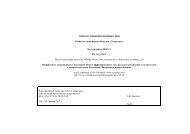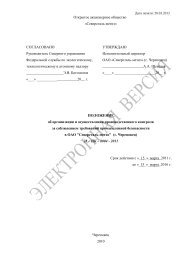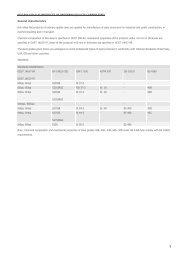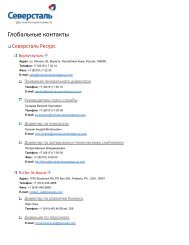Download PDF - Severstal
Download PDF - Severstal
Download PDF - Severstal
Create successful ePaper yourself
Turn your PDF publications into a flip-book with our unique Google optimized e-Paper software.
OAO <strong>Severstal</strong> and subsidiariesOAO <strong>Severstal</strong> and subsidiariesNotes to the consolidated financial statementsfor the years ended December 31, 2008, 2007 and 2006(Amounts expressed in thousands of US dollars, except as stated otherwise)Notes to the consolidated financial statementsfor the years ended December 31, 2008, 2007 and 2006(Amounts expressed in thousands of US dollars, except as stated otherwise)assets for which capitalization of borrowing costs commences on or after the effective date. Therefore there will beno impact on prior periods in the Group’s 2009 consolidated financial statements.Revised IFRS 3 Business Combinations incorporates the following changes that are likely to be relevant to theGroup’s operations:• The definition of a business has been broadened, which is likely to result in more acquisitions being treated asbusiness combinations.• Contingent consideration will be measured at fair value, with subsequent changes therein recognized in profit orloss.• Transaction costs, other than share and debt issue costs, will be expensed as incurred.• Any pre-existing interest in the acquiree will be measured at fair value with the gain or loss recognized in profitor loss.• Any non-controlling (minority) interest will be measured at either fair value, or at its proportionate interest in theidentifiable assets and liabilities of the acquiree, on a transaction-by-transaction basis.Revised IFRS 3 becomes mandatory for the Group’s 2010 annual consolidated financial statements and will beapplied prospectively and therefore there will be no impact on prior periods in the Group’s 2010 consolidatedfinancial statements.IFRS 8 Operating Segments introduces the “management approach” to segment reporting. IFRS 8, which becomesmandatory for the Group’s 2009 consolidated financial statements, will require a change in the presentation anddisclosure of segment information based on the internal reports regularly reviewed by the Group’s Chief OperatingDecision Maker in order to assess each segment’s performance and to allocate resources to them. Currently theGroup presents segment information in respect of its seven combined business and geographical segments(Note 31).Reclassifications and restatementsDuring the current year the Group modified the income statement classification of retirement benefit income andexpense between cost of sales and general and administrative expense to more appropriately reflect their nature.In order to conform to the current year presentation the following reclassifications to the prior years were made:Year ended December 31,2007 2006(Decrease)/increase in cost of sales (25,387) 47,003Increase/(decrease) in general and administrative expenses 25,387 (47,003)Furthermore, in order to conform to the current year presentation the following reclassifications to the prior yearswere made for the bank customer accounts in the Financial segment:3. Summary of the principal accounting policiesThe following significant accounting policies have been consistently applied in the preparation of these consolidatedfinancial statements throughout the Group.a. Basis of consolidationSubsidiariesSubsidiaries are those enterprises controlled, directly or indirectly, by the Parent Company. The financial statementsof subsidiaries are included in these consolidated financial statements from the date that control effectivelycommences until the date that control effectively ceases. The minority interest represents the minorities’ proportionof the net identifiable assets of the subsidiaries, including the minorities’ share of fair value adjustments onacquisitions. Minority interests are presented in the consolidated balance sheet within equity, separately from theparent’s shareholders’ equity.Intra-group balances and transactions, and any unrealized gains arising from intra-group transactions, areeliminated in preparing these consolidated financial statements; unrealized losses are also eliminated unless thetransaction provides an evidence of impairment of the asset transferred.Acquisition of SubsidiariesThe purchase method of accounting was used to account for the acquisition of subsidiaries by the Group.The initial accounting for a business combination involves identifying and determining the fair values to be assignedto the acquiree’s identifiable assets, liabilities and contingent liabilities and the cost of acquisition. If the initialaccounting for a business combination is incomplete by the end of the period in which the combination is effected,the Group accounts for the combination using the provisional values for the items for which the accounting isincomplete. The Group recognizes any adjustments to those provisional values as a result of completing the initialaccounting within twelve months from the acquisition date. As a result goodwill or negative goodwill is adjustedaccordingly.Comparative information presented for the periods before the completing the initial accounting for the acquisition ispresented as if the initial accounting had been completed at the acquisition date.Accounting for business combinations of entities under common controlIFRS provides no guidance on accounting for business combinations of entities under common control. Managementadopted the accounting policy for such transactions based on the relevant guidance of accounting principlesgenerally accepted in the United States (‘US GAAP’). Management believes that this approach and the accountingpolicy disclosed below are in compliance with IFRS.December 31 December 312007 2006Decrease in bank customer accounts - (31,143)Increase in other current liabilities - 31,143Moreover, as discussed in Note 30 these consolidated financial statements have been restated on the effects of theacquisitions from the Majority Shareholder and the final purchase price allocation.Acquisitions of controlling interests in companies that were previously under the control of the Majority Shareholderare accounted for as if the acquisition had occurred at the beginning of the earliest comparative period presentedor, if later, at the date on which control was obtained by the Majority Shareholder. The assets and liabilitiesacquired are recognized at their book values. The components of equity of the acquired companies are added tothe same components within Group equity except that any share capital of the acquired companies is recorded asa part of additional capital. Cash consideration for such acquisitions is recognized as a liability to or a reduction ofreceivables from related parties, with a corresponding reduction in equity, from the date the acquired company is114115
















